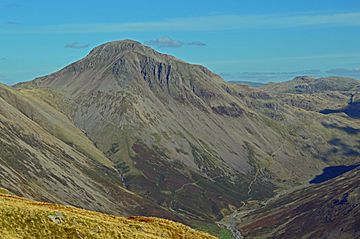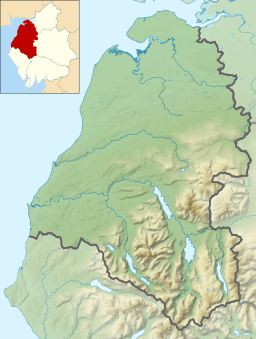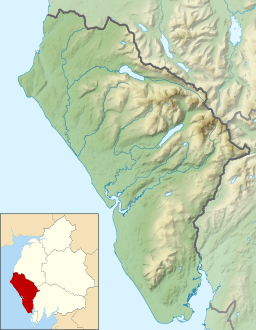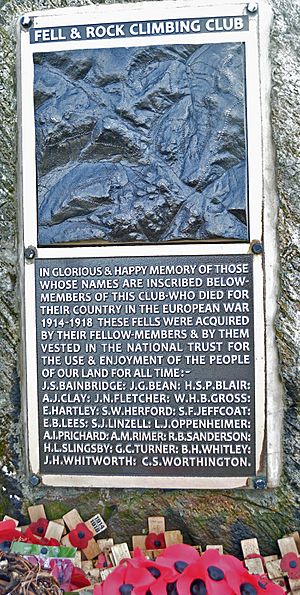Great Gable facts for kids
Quick facts for kids Great Gable |
|
|---|---|

Great Gable from Yewbarrow.
The crag at centre is the Great Napes. |
|
| Highest point | |
| Elevation | 899 m (2,949 ft) |
| Prominence | 425 m (1,394 ft) |
| Parent peak | Scafell Pike |
| Listing | Marilyn, Hewitt, Wainwright, Nuttall |
| Geography | |
| Location | Cumbria, England |
| Parent range | Lake District, Western Fells |
| OS grid | NY211104 |
| Topo map | OS Landrangers 89, 90, Explorer OL4 |
Great Gable is a famous mountain in the Lake District, United Kingdom. It looks like a pyramid when seen from Wasdale. But from other sides, it looks more like a dome. Many people love to hike up Great Gable. There are lots of paths to reach its top. Great Gable is connected to Green Gable by a high mountain path called Windy Gap. It's also linked to Kirk Fell by a lower path called Beck Head.
Contents
Exploring Great Gable's Landscape
Great Gable is part of the Western Fells in the Lake District. These fells form a horseshoe shape around the valley of Ennerdale. Great Gable and its smaller neighbor, Green Gable, stand at the very top of Ennerdale.
A famous walking path called Sty Head is behind these mountains. This path connects Borrowdale to Wasdale. This means Great Gable can be seen from both valleys. It's a very noticeable mountain when you look up from the lake in Borrowdale.
The top part of Great Gable is shaped like a rough square. Each side is about half a mile long. The mountain's faces point towards the four main directions.
Cool Features of the Mountain Sides
The northern side of Great Gable has a big cliff called Gable Crag. You can see it clearly from places like Haystacks. This is the longest cliff on the mountain. Below it are slopes of loose rocks, called scree, leading to the River Liza.
The eastern slopes are steep but have few cliffs. They drop down to Styhead Tarn. A tarn is a small mountain lake. Styhead Tarn is about 30 feet (9 meters) deep. It's a popular spot for wild camping and is said to have trout.
The southern side of Great Gable drops sharply towards Lingmell Beck. This stream feeds into Wast Water. Right below the top are the Westmorland Crags. Lower down, you'll find other rock formations like Kern Knotts, Raven Crag, and Great Napes. These are also surrounded by large piles of scree.
Connecting Paths and Ridges
From the north-western corner of Great Gable, a ridge connects to Kirk Fell. This ridge crosses a low point called Beck Head. There's often a small tarn here, and sometimes a second one after heavy rain.
The main ridge of the Western Fells continues from Great Gable to Green Gable. It drops down to Windy Gap as it goes around Gable Crag. This path is rocky and well-worn by many walkers.
The south-eastern ridge leads to the Southern Fells. It crosses the important path of Sty Head. This is a major meeting point for hikers and climbers. On the other side of Sty Head is Great End, part of the Scafells.
What Great Gable is Made Of
Great Gable is mostly made of volcanic rocks. The very top is made of a type of lava rock called dacite. Below this, you'll find layers of tuff, which are rocks made from volcanic ash. There's also breccia, a rock made of sharp, broken pieces.
A type of rock called porphyry forms Kern Knotts. This rock was pushed up from deep inside the Earth.
The Summit of Great Gable
The very top of Great Gable is covered in large rocks. The highest point has a rock outcrop with a cairn (a pile of stones). There's also a special plaque on the summit rock. It remembers members of the Fell & Rock Climbing Club who died in World War I. A special service is held here every year on Remembrance Sunday.
The club bought 3,000 acres of land, including Great Gable. They gave it to the National Trust to honor these members. The plaque was put in place on Whit Sunday in 1924. About 500 people were there for the dedication. The original bronze plaque was very heavy. It was replaced in October 2013 with a new one that corrected some spelling mistakes.
Because Great Gable is in the middle of the Lake District, its summit offers amazing views. You can see all the main mountain groups. However, only Wast Water and Windermere are the lakes you can spot.
A little to the south-west of the summit is the Westmorland Cairn. Two brothers named Westmorland built this cairn in 1876. They thought this spot had the best view in the Lake District. From here, the ground drops into the upper Wasdale valley. Other cairns mark the top of Gable Crag. The summit is also a popular place for scattering ashes after cremation.
Climbing to the Top
You can start climbing Great Gable from all the main valleys around the central Lake District. A popular way to go is from Seathwaite in Borrowdale. This route goes up Sour Milk Gill. First, you climb Green Gable, then you cross Windy Gap to reach Great Gable.
Other Walking Adventures
Alfred Wainwright, a famous fell walker, described a route called the 'Gable Girdle'. This is a walk that goes around the middle of the mountain. It connects several existing paths. These include the north and south traverses, Styhead Pass, Aaron Slack, and Moses Trod.
The south traverse climbs west from Sty Head. It gives access to the Napes and Kern Knotts, which are popular for rock climbers. This path offers great views of famous climbing spots like Napes Needle and Sphinx Rock. The north traverse goes under Gable Crag to Windy Gap.
In the west, these two paths connect with a section of Moses Trod. This path goes up the southern side of Beck Head. "Moses" was a trader or smuggler who worked at Honister Quarry. His route went around the mountain to get his illegal whisky to markets in Wasdale. Moses Trod was also used to carry slate from the quarry to the coast, avoiding big uphill sections. Aaron Slack is a quick way down from Windy Gap to Sty Head.
Rock Climbing Challenges
Great Gable has cliffs on its north side (Gable Crag) and south side (Westmorland Crags, the Napes, and Kern Knotts). The Napes are very important in the history of English rock climbing.
In June 1886, Walter Parry Haskett Smith climbed a separate rock tower called Napes Needle. Many people believe this climb marked the start of rock climbing as a sport in England. Before this, climbing was just something mountaineers did to reach a summit.
Images for kids
-
The southern flank of Great Gable seen from the summit of Scafell Pike








